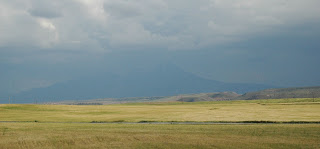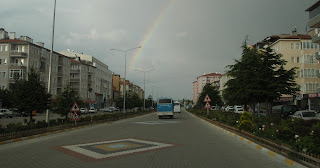We left our Konya campsite, rather sadly bidding goodbye to Turka. He relished the chop we gave him this morning (after another we gave him last night), and did not seem as ravenous as on the first day. He lay on the paving stones by our van, quite contented after his meal. Let's hope future campers treat him kindly!
Today was election day in Turkey. As we drove, we expected to see the kind of hullabaloo we have in Oz, but it looked totally quiet. Apparently, as in Australia, the polling booths are at the schools, but there is no electioneering whatsoever allowed today — no handing out of 'How to Vote' cards. We have noticed that the people here are rather savvy with their voting, and all seem to have made up their minds well before polling day. Anyway, it's been a very interesting lead-up, so let's see how the whole thing pans out!
We went to the Konya War Memorial, only to find it closed. It's apparently closed on Sundays. Pity. But at least we can say we have visited two of the major memorials associated with Turkey's War of Independence (for so the First World War was to Turkey, with Atatürk's campaign to throw the occupying forces out of Turkey being its logical continuation!
We drove out of Konya and made our way to Çatalhöyük. At the start, we had the Garmin incorrectly set — Konya has a suburb of Çatalhüyük — but we soon realized the error of our ways and made our way — about 50km — towards Çatalhöyük. Çatalhöyük doesn't appear on our maps, nor in the Garmin, but we knew it was somewhere near Çumra. We got to Çumra and then asked for directions. A group of men at a service station were most helpful, but as Warren has no Turkish, and they had no English, a lot of miming, and a bit of Pictionary, and they directed us towards Çatal Höyük Caddesi, the street in Çumra that leads out to Çatalhöyük. We actually missed it by one block — it looked like we were going to run out of road — but a query to a local (using pointing and the booklet we already had about the site) let us go over that one block, and we were on the right road. It was all plain sailing from there!
Çatalhöyük was a site Warren had learned about while he was studying archaeology, and he really wanted to see it. The best summary comes from a sign we saw as we entered the site:
Çatalhöyük was discovered by James Mellaart, David French and his colleagues in 1958, and is two separate settlements named as Eastern and Western Çatalhöyük. Çatalhöyük was one of the first settlements where people first settled down and started farming, with dense population, some 9000 years ago. Almost 8,000 people lived here in houses huddled closely together. There are no roads between the houses, and people entered them through the roof. The people of Çatalhöyük buried their dead within the houses where they lived. They drew carefully detailed pictures of wild animals inside their dwellings, and also kept the horns and skulls of these animals at certain sites.
Eastern Çatalhöyük was settled between 7400 and 6000 BC, in the Neolithic Age, and Western Çatalhöyük between 6000 and 5500 BC, in the Chalcolithic Age.
Çatalhöyük has been placed on the Interim List of UNESCO World Heritage. In the tumulus where an excavation was carried out by James Mellaart in 1961-1963 and 1965, excavation work has been carried out since 1993 by an international team led by Prof. Dr. Ian Hodder.
Obsidians, ceramics, mother goddess and animal figures found at Çatalhöyük are displayed in the Konya Archaeological Museum and the Ankara Anatolian Civilizations Museum.
Eastern Çatalhöyük was settled between 7400 and 6000 BC, in the Neolithic Age, and Western Çatalhöyük between 6000 and 5500 BC, in the Chalcolithic Age.
Çatalhöyük has been placed on the Interim List of UNESCO World Heritage. In the tumulus where an excavation was carried out by James Mellaart in 1961-1963 and 1965, excavation work has been carried out since 1993 by an international team led by Prof. Dr. Ian Hodder.
Obsidians, ceramics, mother goddess and animal figures found at Çatalhöyük are displayed in the Konya Archaeological Museum and the Ankara Anatolian Civilizations Museum.
We were surprised, because you come to the site and are met by a guide/security man. There are no charges — the site has free entry! The guide first takes you into the visitor centre, where they have set up very good displays about the ancient history of the site, and about the history of the digs. He then explains to you the route you can take as you walk around the site, gives you a very good printed guide to the site, and lets you loose. This site works on trust, and it seems that this trust has not been abused.
Just inside the entrance is a reconstructed dwelling that has been used for experimental archaeology, trying out different ways of painting the walls, and different ways of heating (burning wood or animal dung), and lighting (oil lamps, burning brands) — but it lets you visualise the way a dwelling might have looked and worked.
So we first walked up the mound to the Western Shelter, which contained the most recent excavations. You must remember that the dwellings here were made of adobe brick, so the excavations have had to be meticulous, and there are not the massive stone edifices you find with later civilizations. But the archaeology here has been superb, and the information retrieved incredible.
When we first went into the Western Shelter, we noticed animal and bird tracks on the topmost surface. At first we thought they might have been put there as a sort of teaching tool, but then we espied one of the tracks in the act of creation — by a lizard.
We looked over the Western Shelter dig, and then went on to the Southern Shelter, where more extensive work has been carried out. They have carried out excavation in parts of it down to the bedrock, to establish the extent of the site. They have found at least 13 levels of houses built over the remains of previous occupation. The site is massive.
We walked the site for a couple of hours, absolutely amazed at the amount of work that has been done — and at the amount that has been left for the future.
We then went out to the cafeteria outside, and settled down for a caffeine fix before continuing on our way.
Driving out through Küçükköy we noticed more tractors than cars on the roads, and a flock of geese taking full advantage of a waterway. We noted a 'tent city' of itinerant workers — not like in Australia, where itinerant workers expect to be put up by their employers, here in Turkey they have to be self-sufficient. Just up the road was a group of fishermen — were they brewing çay, or were they cooking their catch?
We were looking for a place to stop, and then we realised that we were only about 80km short of our Göreme destination, and Suzie said she was up for it, so we decided to press on.
But we made our destination near Göreme, Kaya Camping, in time to settle in and watch another spectacular sunset. Our site at Kaya Camping overlooks Kiliçlar valley, and some of the incredible Cappadocian scenery.
As we registered at reception, we asked if we might be able to have one of the famous Cappadocian balloon flights on the day after tomorrow (tomorrow would be too soon, and anyway, we wouldn't get a flight at such short notice). We were told we would be able to get a flight on Tuesday morning — so that's something to look forward to.
Distance driven — today, 230 miles ( 370 km ); to date, 21,829 miles ( 35,131 km )















































Boy, its a huge country that Europe and whatever they call the area you are in now. Capadocia? Where's that at? The scenery is so variable isn't it. The weather shots were great too. I'm missing Turka, by the way. That ancient dig area-how rewarding for the archaeologists, I like the covers they erect. It must date back centuries if you have 12 levels of housing one atop other- tho I don't know the life of an adobe brick. Got another one set of competencies finished today. Only 5 to go! Had to get my slides done for my 15 min talk for next Wednesday. Must do a reference list to hand out and make sure I've got dot points on my printouts. I think what I've done is enough. I put little cartoon preggy women all through thanks to clip art-except for the one about the risky dangers. Must drop the slides onto a memory stick and get some help to make sure they all disappear smoothly the way I want them, to as I click mousie. Anyway, thanks for the tour. On ya. CJ
ReplyDelete